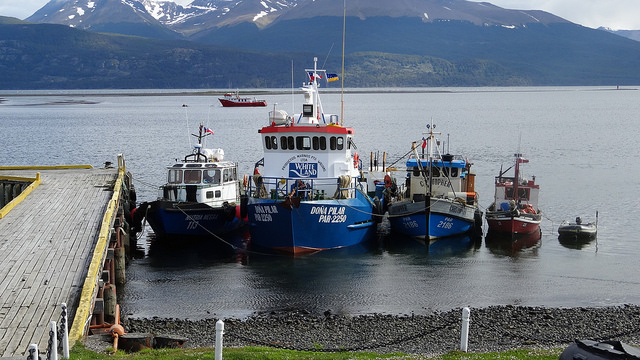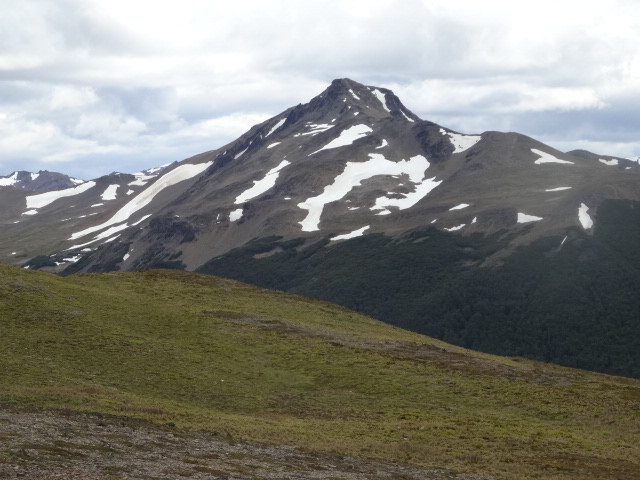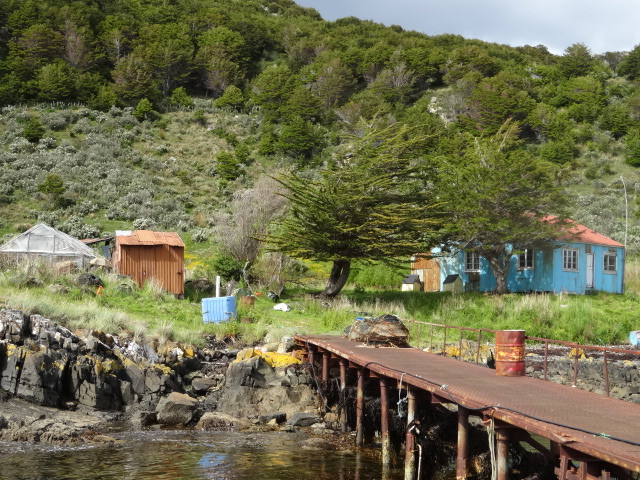From the Field: Bill Buck in Cape Horn 2014, Part 7
Posted in Travelogue on April 4, 2014 by Bill Buck
William R. Buck, Ph.D., is the Mary Flagler Cary Curator of Botany at The New York Botanical Garden. Every January for the last three years, Dr. Buck, a moss specialist, and a team of colleagues have journeyed to the Cape Horn region at the southern tip of South America to document the area’s rich diversity of mosses and search for new species.
January 18, 2014; Puerto Toro, Isla Navarino, Chile (55°04’S, 67°04.5’W)

Our time in Puerto Williams, an interruption in our fieldwork, raced by. We arrived at 8:30 a.m. on the 16th after a four-and-a-half-hour trip from a collecting site on the northwest coast of Navarino. We decided to have lunch and dinner at a local restaurant; the stable environment would be a welcome change after so many meals on the Doña Pilar.
After lunch, I skipped flan and headed back to the house where we were staying to be picked up for a public meeting with some politicians who had come to Puerto Williams for the occasion. I was scheduled to speak in support of creating a ministry of science for Chile. But due to a misunderstanding, I wasn’t the only one they wanted, so we swung by the restaurant to pick up more warm bodies. Barb Andreas, Barbara Murray, and John Brinda volunteered.
The event was held along a trail in Omora Park, and we were told to play it by ear. I was surprised by the size of the group that arrived—at least 30 people between the politicians, presenters, and reporters. I briefly explained our project. The statistic that most impressed the group was the fact that there are only six species of trees in the region but about 500 species of mosses.
We had to cut out after the meet-and-greet so we could be on time for a 5 p.m. ceremony featuring our expedition member Ernesto Davis, our main reason for coming to Puerto Williams. In such a small place (population about 1,600), conflicting events are rare.
Ernesto discussed his new book on the history and ecology of Navarino and its potential for ecotourism. The group of about 20 people included the mayor and many military and police officers. Afterward, we headed back to the restaurant where we’d eaten lunch. We had 8:30 dinner reservations, and after such an active day, it was hard to believe we’d only arrived in Puerto Williams 12 hours earlier. It was the general consensus that the ship’s cook did a better job than those in the restaurant. We welcomed the prospect of spending the night ashore in large beds with a close, heated bathroom.

The next day was strenuous for many of the team. Several of us had never ascended Cerro Bandera, the mountain behind Puerto Williams, and it provided a rare opportunity to get into an alpine habitat above the treeline. The weather looked promising, with clear skies and calm winds.
Barb, John, Matt von Konrat, and Laura Briscoe set out with the intention of spending the day atop the mountain. We dropped them off at the trailhead at 10 a.m. with a scheduled pick-up of 6 p.m. They all made it to the summit and returned weary but pleased. Juan Larraín, Ernesto, and I took our lunch and headed west along the island’s only road toward Puerto Navarino. We could easily see the city of Ushuaia, in Argentina, across the Beagle Channel.
Around noon we stopped at a site that I had previously visited, a location both beautiful and rich in mosses. After picnicking on the grass, we went our own ways, Juan and Barbara toward a small waterfall, Ernesto to a comfortable place to read his book, and I toward a large rock outcropping.
Before we knew it, we had to head home, but a dead battery put a halt to our plans. In the three hours we had been there, only a single car had passed. After unsuccessful attempts to push the car onto the road, Ernesto and Juan made for a nearby hilltop in hopes of finding cell phone coverage. Shortly afterward, two vehicles passed in tandem, and by some miracle they happened to have a spare battery between them.
We ate quickly aboard the ship as we all had specimens to process. I finished by 10 p.m. and headed for bed.
We could not leave for the Wollaston Islands until this morning because the ship was awaiting a produce delivery from the weekly Punta Arenas ferry. For most of the afternoon, I stood on the bow of the ship to avoid the chilling tailwind. I wondered why no one else was outside, but with the spectacular scenery, I was soon absorbed in my own thoughts. I later discovered that almost everyone else had fallen asleep after taking seasickness medication in anticipation of rough seas that we never encountered.

Many members of the group emerged from their bunks, groggy from the medication, as we pulled into Caleta Piedras on Isla Picton (55°02’S, 67°01’W). We were only stopping there for water before making the quick journey across to Puerto Toro, the southernmost inhabited village in the world, where we will spend the night. For the four-hour journey to the Wollastons in the early morning hours, we’ve been told to expect 12- to 15-foot-high waves.
We were fortunate to enjoy calm seas during my last trip to the Wollastons, but that doesn’t seem to be in the cards this trip. Once we reach safe harbor at Isla Grevy, we can set out each day to one of various surrounding islands.
We only have another week of fieldwork before we return to Puerto Williams to gather up our dry specimens and return to Punta Arenas. I just hope to awaken in the Wollaston Islands tomorrow morning. Time is flying by, and we still haven’t reached the target area for this year’s fieldwork. It’s all I can do to keep my frustration at bay.
Past Expedition Entries:
Photos supplied by Barbara Andreas.

